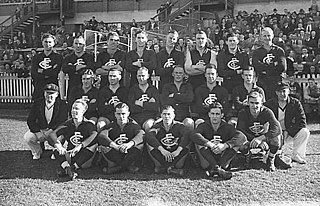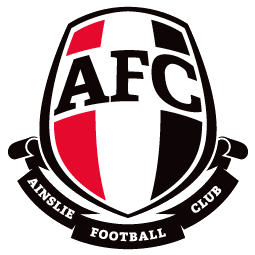
The Western Bulldogs are a professional Australian rules football club based in West Footscray, a suburb of Melbourne in Victoria, Australia. The club competes in the Australian Football League (AFL), the sport's premier competition.
Alan John Schultz was an Australian rules footballer who played for Footscray in the Victorian Football League (VFL) between 1958 and 1968.
Peter John HudsonAM is a former Australian rules footballer who played for the Hawthorn Football Club in the Victorian Football League (VFL) and for the New Norfolk Football Club and Glenorchy Football Club in the Tasmanian Australian National Football League (TANFL).
Jason Hadfield Dunstall is a former Australian rules footballer who played for the Hawthorn Football Club in the Australian Football League (AFL).
Simon Francis Beasley is a former Australian rules footballer who played for the Swan Districts Football Club in the West Australian Football League (WAFL) and for the Footscray Football Club in the Victorian Football League (VFL).
Tony Liberatore is a former Australian rules footballer who represented the Western Bulldogs in the Australian Football League (AFL).
David Alexander Parkin is a former Australian rules footballer and coach who played for the Hawthorn Football Club in the Victorian Football League (VFL) and for the Subiaco Football Club in the Western Australian National Football League (WANFL).
Rivalries in the Australian Football League exist between many teams, most of which typically draw large crowds and interest regardless of both teams' positions on the ladder. The AFL encourages the building of such rivalries, as a method of increasing publicity for the league, to the point of designating one round each year as "Rivalry Round" when many of these match-ups are held on the one weekend. Whilst some rivalries, such as between teams from adjacent areas, are still strong, the designation of an entire round of fixtures as a Rivalry Round is often criticised due to some arbitrary match-ups, or ignoring stronger and more recent rivalries.
The 1986 VFL season was the 90th season of the Victorian Football League (VFL), the highest level senior Australian rules football competition in Victoria. The season featured twelve clubs, ran from 29 March until 27 September, and comprised a 22-game home-and-away season followed by a finals series featuring the top five clubs.
The 1928 VFL season was the 32nd season of the Victorian Football League (VFL), the highest-level senior Australian rules football competition in Victoria. The season featured twelve clubs and ran from 21 April to 29 September, comprising an 18-match home-and-away season followed by a four-week finals series featuring the top four clubs.
The 1960 VFL season was the 64th season of the Victorian Football League (VFL), the highest level senior Australian rules football competition in Victoria. The season featured twelve clubs, ran from 16 April until 24 September, and comprised an 18-game home-and-away season followed by a finals series featuring the top four clubs.
The 1962 VFL season was the 66th season of the Victorian Football League (VFL), the highest level senior Australian rules football competition in Victoria. The season featured twelve clubs, ran from 21 April until 29 September, and comprised an 18-game home-and-away season followed by a finals series featuring the top four clubs.
The 1969 VFL season was the 73rd season of the Victorian Football League (VFL), the highest level senior Australian rules football competition in Victoria. The season featured twelve clubs, ran from 5 April until 27 September, and comprised a 20-game home-and-away season followed by a finals series featuring the top four clubs.

The 1945 VFL season was the 49th season of the Victorian Football League (VFL), the highest level senior Australian rules football competition in Victoria. The season featured twelve clubs, ran from 21 April until 29 September, and comprised a 20-game home-and-away season followed by a finals series featuring the top four clubs.
The 1971 VFL season was the 75th season of the Victorian Football League (VFL), the highest level senior Australian rules football competition in Victoria. The season featured twelve clubs, ran from 3 April until 25 September, and comprised a 22-game home-and-away season followed by a finals series featuring the top four clubs.
The 1972 VFL season was the 76th season of the Victorian Football League (VFL), the highest level senior Australian rules football competition in Victoria. The season featured twelve clubs, ran from 1 April until 7 October, and comprised a 22-game home-and-away season followed by a finals series featuring the top five clubs – an increase from the four clubs which had contested the finals in previous years.
The 1975 VFL season was the 79th season of the Victorian Football League (VFL), the highest level senior Australian rules football competition in Victoria. The season featured twelve clubs, ran from 5 April until 27 September, and comprised a 22-game home-and-away season followed by a finals series featuring the top five clubs.
The Gardiner Medal was an Australian rules football award, formerly awarded to the best and fairest player in the VFL Reserves competition.

Ainslie Football Club is a semi-professional Australian rules football club based in Canberra, in the Australian Capital Territory.
The AFL Australian Football League is the top professional Australian rules football league in the world. The league consists of eighteen teams: nine based in the city of Melbourne, one from regional Victoria, and eight based in other Australian states. The reason for this unbalanced geographic distribution lies in the history of the league, which was based solely within Victoria from the time it was established in 1897, until the time the league expanded through the addition of clubs from interstate to the existing teams starting in the 1980s; until this expansion, the league was known as the VFL (Victorian Football League).


